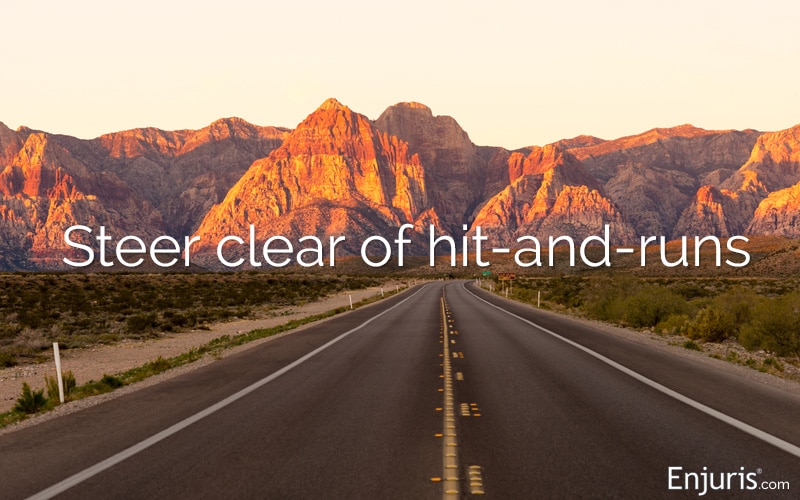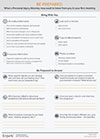
Understand your rights and obligations following a crash
This comprehensive guide takes an in-depth look into Nevada’s hit-and-run laws, the associated penalties, and the necessary steps to take if you're the victim or perpetrator of a hit-and-run accident.
After being involved in a motor vehicle accident, your instinct might be to flee the scene—especially if you believe you’re at fault. However, fleeing the scene of an accident is a criminal offense in Nevada.
How common are hit-and-run accidents in Nevada?
Although Nevada does not keep up-to-date hit-and-run statistics, hit-and-run accidents account for roughly five percent of all traffic fatalities across the nation.
There were 285 fatal crashes in Nevada in 2019, which means we can estimate that there were roughly 14 fatal crashes caused by hit-and-run drivers that same year.
What is Nevada’s hit-and-run law?
Nevada’s hit-and-run laws can be found in Nevada Revised Statutes 484W.010-130.
Nevada’s hit-and-run laws require all drivers involved in an accident in Nevada to take the following steps:
- Stop their vehicle at the scene of the accident (or as close to the scene as possible),
- Provide their name, address, insurance company, insurance policy number, and vehicle license number to any person involved in the crash, and
- Render reasonable assistance to anyone injured.
If a Nevada driver hits an unoccupied vehicle, the driver must:
- Stop their vehicle at the scene of the accident, and
- Locate the owner of the property or leave a written note providing the driver’s name and contact information.
What are the penalties for a hit-and-run in Nevada?
The penalties for a hit-and-run in Nevada range from a misdemeanor to a felony, depending on the nature of the accident.
Here’s a closer look:
| Hit-and-run penalties in Nevada | |||
|---|---|---|---|
| Type of accident | Charge | Jail | Fine |
| Property-damage only | Misdemeanor | Up to 6 months | Up to $1,000 |
| Bodily injury or death | Category B felony | 2-20 years | $2,000-$5,000 |
What steps should you take if you fled the scene of an accident?
Fleeing the scene of an accident is never the right decision, but it’s an understandable reaction, particularly if the accident was your fault or you’re afraid of being confronted by the innocent driver.
If you flee the scene of an accident, you should immediately call the nearest police station and provide notice of the accident, along with all of your contact information. Doing so might not save you from a hit-and-run conviction, but it’s the right thing to do, and it may result in you receiving a lesser sentence than if law enforcement is forced to track you down.
How do you recover damages after a hit-and-run crash?
Recovering damages after a hit-and-run accident can be challenging, especially if the offender remains unidentified.
If you’re fortunate enough to identify the offender, you can file a claim with their insurer or file a personal injury lawsuit against them. This is one reason it’s important to have notified the police after a hit and run.
If you can’t identify the hit-and-run driver, your insurance might cover some of the damages, but only if you have uninsured motorist (UM) coverage or some other optional coverage that pays for damages regardless of who’s at fault for an accident.
Learn more about auto insurance laws in Nevada, including the types of car insurance that may cover a hit-and-run crash.
What should you do if you’re the victim of a hit-and-run accident?
If you’re the victim of a hit-and-run crash, first ensure you’re safe and call 9-1-1. If it’s safe to do so, document the scene as much as possible by noting any potential witnesses and taking photographs.
Once things have settled down, reach out to an experienced personal injury attorney to learn about your legal options for recovering damages.
5 FAQs about hit-and-run accidents in Nevada
Still have questions about hit-and-run accidents? Let’s see if we can get them answered:
Passengers are generally not legally responsible for the actions of a fleeing driver unless they actively encouraged the driver to flee.
In Nevada, the statute of limitations for personal injury cases is two years, meaning you have two years from the date of an accident to file a lawsuit or the lawsuit will be forever barred. In the case of hit-and-run accidents, the statute of limitations may be tolled (i.e., paused) until the hit-and-run driver is identified.
You can be charged with a hit-and-run in Nevada even if the accident was not your fault.
People flee accident scenes for all sorts of reasons. A person might flee because they’re afraid to confront the victim, they’re intoxicated, they’re uninsured, they panic, or they didn’t realize they hit something.
Reporting a hit-and-run accident increases the chances that the hit-and-run driver will be identified. What’s more, Nevada law requires drivers to report crashes. If you fail to report a crash, you risk having your license suspended for up to one year.
Hit-and-run crashes can be overwhelming. If you’ve been involved in a hit-and-run crash, consider reaching out to an experienced Nevada attorney. Though the crash was overwhelming, the pursuit of damages doesn’t have to be. Here’s a worksheet to help you prepare for your first meeting with an attorney:

A worksheet to prepare for your first meeting with a personal injury attorney – what to bring, what they'll ask
Download in PDF format
See our guide Choosing a personal injury attorney.
